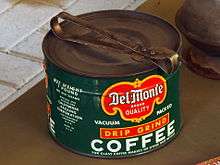Standish Lawder
Standish Dyer Lawder (1936 – 21 June 2014) was an American artist, art historian and inventor, who contributed to the structural film movement in the late 1960s and early 1970s.[1]
Biography
Born in Connecticut in 1936, Lawder attended Williams College and the National Autonomous University of Mexico as an undergraduate, and studied at the Ludwig Maximilian University of Munich.[2] While at the University of Munich, he became a test subject for a neurologist researching phosphenes at around 1960.[3] During these experiments, he was injected with measured amounts of LSD, mescaline and psilocybin, and "spent a whole day in the clinic".[3] In this, he became an early subject of psychedelics.[3] Afterwards, he received his Doctor of Philosophy as an art historian at Yale University.[2] His thesis, which was later published as The Cubist Cinema, examines the correlation between the history of film and its impact on modern art, described as a holistic overview by Anthony Reveaux in Film Quarterly.[4]
His body of work is purported to span over 25 films and his literary works encapsulates several essays on experimental film.[2] His first endeavors with experimental films started in his basement during a sabbatical of his in the late 1960s and early 1970s.[5] One of his works during this span, Necrology, has been cited by fellow filmmaker Hollis Frampton as "the sickest joke I've ever seen on film".[6]
Lawder died in 2014.[7]
Inventions

For production of his first two films, Runaway and Corridor, Lawder built his own contact printer using a incandescent light bulb housed within a coffee can.[8][9] With it, he would expose his films by manipulating the brightness of the light bulb, then shined the beam it created through the flashlight tube to the film gate of his camera.[8]
Preservation
The Academy Film Archive has preserved several of Standish Lawder's films, including "Necrology," "Catfilm For Katy and Cynnie," and "Raindance."[10]
Selected filmography
- 3 x 3: A Tic-Tac-Toe Sonata in 3 Moves (1963)
- Budget Film (1969)
- Catfilm for Ursula (1969)
- Construction Job (1969)
- Eleven Different Horses (1969)
- Headfilm (1969)
- Roadfilm (1969)
- Runaway (1969)
- Specific Gravity (1969)
- Corridor (1970)
- Dangling Participle (1970)
- Intolerance (Abridged) (1972)
- Necrology (1970)
- Color Film (1972)
- Prime Time (1972)
- Raindance (1972)
- Sixty Suicide Notes (1972)
- Sunday in Southbury (1972)
- Automatic Diaries 1971–73 (1973)
- Catfilm for Katy and Cynnie (1973)
- Regeneration (1980)
Bibliography
Books
- The Cubist Cinema. New York: New York University Press. 1970. ISBN 978-0814749579.
Essays
- "Ernest Wilhelm Nay: An Evaluation of His Recent Paintings". Art Journal. College Art Association. 21 (2): 101–3. Winter 1961–62. JSTOR 774261.
- ———; Knoll, M.; Kugler, J.; Höfer, O. (1963). "Effects of Chemical Stimulation of Electrically-Induced Phosphenes on their Bandwidth, Shape, Number and Intensity". Stereotactic and Functional Neurosurgery. Basel. 23 (3): 201–26. doi:10.1159/000104299. ISSN 1011-6125.
- "Fernand Leger and Ballet Mechanique". Image. London. 2 (6). October 1965.
- Sitney, P. Adams, ed. (1975). "Eisenstein and Constructivism". Essential Cinema. 2. New York University Press: New York. 1. ISBN 978-0814777671.
References
- ↑ "One Night, Standish Lawder". Harvard Film Archive. Cambridge, Massachusetts: Harvard University Library. 23 September 2013. Retrieved 8 November 2013.
- 1 2 3 "Standish Lawder biography". The Visual Arts Department at UC San Diego. University of California, San Diego. 21 June 2013. Retrieved 8 November 2013.
- 1 2 3 Halter, Ed (4 December 2007). "Visions of Grandeur". The Village Voice. New York City. Retrieved 7 December 2013.
- ↑ Reveaux, Anthony (Summer 1976). "The Cubist Cinema by Standish D. Lawder". Film Quarterly. Berkeley, California: University of California Press. 29 (4): 27–9. doi:10.2307/1211605.
- ↑ Treasures IV: American Avant-Garde Film, 1947–1986 (Media notes). Los Angeles: Image Entertainment. 2008. NATD4737DVD. Archived from the original on 6 September 2011.
- ↑ Gerard, Lillian; Shaw, Elizabeth (3 March 1970). "Cineprobe presents experimental films by Standish Lawder" (PDF) (Press release). New York City: Museum of Modern Art. Retrieved 8 November 2013.
- ↑ Hudson, David. "Standish Lawder, 1936 – 2014". Fandor. Retrieved 20 May 2014.
- 1 2 Toscano, Mark (28 November 2007). "A contact printer". Preservation Insanity. Los Angeles: Blogger. Retrieved 8 November 2013.
- ↑ "Stu Brown Sextet: Dinner Music for a Pack of Hungry Cannibals" (Press release). London: no.w.here. 14 October 2008. Retrieved 10 November 2011.
- ↑ "Preserved Projects". Academy Film Archive.